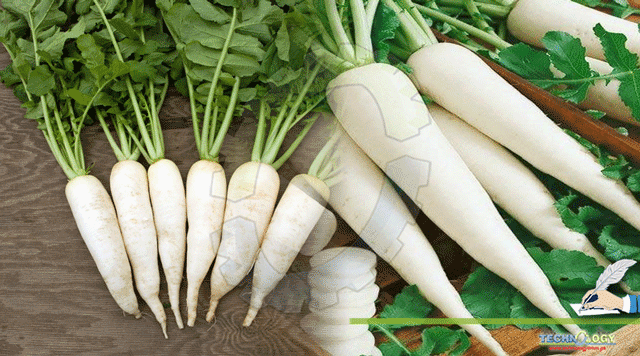Radish originated in China thousands of years ago and gradually spread west. It became an important food of ancient Egypt, Greece, and Rome. In 700 AD it was introduced into Japan and the middle east.

By Iqra Yasmeen, Dr. Abdul Ghani, Samra Gulzar
It appears to have reached England around 1550 and become popular there by 1586. A long white type of radish first appeared in Europe. Radish is grown now in all parts of the world including temperate, tropical and sub-tropical regions. The major identified districts of Pakistan for radish production are Sheikhupura, Sahiwal, R.Y. Khan, T.T. Singh and Okara.
Scientific Name: Rhapanus sativus
Common Name: Radish
Family: Brassicaceae
The word radish is derived from the Latin word radix means root. The scientific name of the genus, Raphanus, has been derived from the Latin word ‘raphanos’ meaning ‘easily reared’. Radish is an important kitchen garden and cash crop. It is grown for its fleshy, edible roots and tender leaves that are eaten raw in a salad or cooked as a vegetable.
Radish the richest source of iron, calcium and sodium. As compared to roots radish leaves have more calcium, vitamin c, protein, phosphorus and proteins.
Chemical analysis shows that per 100 g radish root contains 94.4 percent moisture. It also contains 3.4 g of carbohydrates, 35mg of calcium, 15 mg of vitamin C, 0.02mg of riboflavin. 0.7g of protein, 0.06mg of thiamine and 0.04 mg iron is also present.
Radish grows in all types of soil but gives better results in fertile soil. Loamy, sandy soil is best. Aim for a pH between 5.8-6.8. Radishes require full exposure to sunlight and can be grown in a wide variety of soil types. This vegetable grows best at a cool or moderate temperature. In the tropical regions, it requires a lower temperature of 15 to 25 degree to grow fully. Light, friable loam soil that contains samplehunus is best suited for its cultivation. The roots become ready for harvesting in 40-45 days after sowing depending on the variety.
Medicinal use of Radish
Radish is full of indigestible carbohydrates or roughage. This not only facilitates healthy digestion, retains water, cures constipation and gives relief from piles. It helps in weight loss by not adding many calories to your system. It satisfies your hunger by filling your stomach.
By relieving congestion from within the respiratory system radish is a good food source for people suffering from breathing disorders like asthma or bronchitis.
Radish contains vitamins C, B and K. It also offers folate. Essential minerals like manganese, magnesium, calcium, iron, phosphorous, copper and zinc are also present.
It is compatible with a weight loss plan. Eating radishes can satisfy your appetite without increasing the number of calories. It is a good alternative for those who want to lose weight due to rich in fiber and water, low in carbohydrates.
Eating radishes on a regular basis promotes the good health and appearance of the skin. They contain vitamin C (collagen promoter), phosphorus, zinc, vitamin B, and water help hydrate, regenerate, and nourish the different layers of the skin. Due to its disinfectant properties, it is useful in the treatment of skin disorders like rashes, cracks and dry skin.
Radish has an impact on cancer prevention. It contains folic acid, vitamin C, anthocyanin which is used in the prevention of cancer. It plays a role in the destruction of cancer cells, by altering their genetic pathways and causing apoptosis (cell death) because of antioxidants and isothiocyanate compounds.
Radish juice helps to remove dandruff and treat hair fall by rubbing on the scalp. A mixture of radish juice and olive oil helps to treat dry skin and cracks. Consuming radish regularly helps to eliminate dandruff. It makes your hair healthy and shiny, and even makes hair roots stronger and scalps healthier. Smashed raw radish acts as a natural cleanser and as an effective face pack.
Non-medicinal uses of radish
The growing Radishes increase soil fertility, suppress weeds, relieve soil compaction, and prevent soil erosion.
Side effects of Radish
Gastric Irritation. Allyl isothiocyanate is a sulfur compound present in radish that may have an irritant action on the stomach mucosa.
Allergic Reaction. Radish contains a by-product of glucosinolate known as diallyl sulfide causes potential allergen and irritant to many people. Allergy usually begins at the fingertips. It can cause rhinitis, contact dermatitis, allergic asthma, and anaphylactic shock in susceptible people.
Radish has diuretic properties that stimulate the production of urine. Consumption of too much radish cause dehydration, low blood pressure, and hypoglycemia. People with gallstones and pregnant women should avoid it.
Authors : Iqra Yasmeen, Dr. Abdul Ghani, Samra Gulzar University of Sargodha